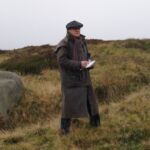
Sight:
Sight for the artist, is about really learning to observe, to see not simply to look: to interpret rather than to merely copy. Sight enables you to pick out the most important aspects of a scene. Sight allows you to observe light and dark, where is the light coming from and where do the shadows fall, this has an effect on the colours you use in your landscape Use you eyes like you are making a film with a camera, carefully checking the scene of the movie before going for a ‘take’ I am forever painting pictures in my mind, practising my ability to remember what I have observed and imagining how I am going to capture this in my actual painting.
Hearing:
Hearing is perhaps the sense that most easily provides inspiration. Out in the countryside, the sound of the whistling wind, the splattering of rain drops, the noise and drama of thunder and lightning all have immensely inspiring qualities.
On a calm day, too, the pleasant noise of animals and the lovely sound of birdsong create a peaceful and content atmosphere. I think of these as the ‘music of the moor’ and always try to reflect this in my painting.
Touch:
Touch is a form of communication and I often pick up blades of grass, twigs, soil and rocks in the countryside so that I can learn about there shape, form and texture. (Applying the rules of the countryside please leave things as you found them).
You can also feel other elements of the landscape such as the driving rain, the chill of a cold day or the heat of the sun. This knowledge is invaluable to me when portraying these in my paintings. It adds reality to your work.
Smell:
The smells of the landscape are very evocative; the fragrance of wild flowers, heather and bracken; the saltiness of the sea or the smell of grass after rain.
Imagine trying to paint a view containing a railway tunnel. When you first approach you think of darkness – colour. Then your sense of smell takes over; you smell the dampness and the fustiness of the tunnels interior. As the sun has never reached inside the tunnel, it remains earthy and dank, like the smell of newly dug potatoes. I often say” if you can’t smell it, you can’t paint it”
When you are out sketching make a note of what you see, hear and touch What is the weather like, can you feel the sun or rain on your face?
What is the ground like under your feet, is it hard grit stone or soft boggymoorland? What can you smell?
This all helps you to build up a picture in your mind of what you want to capture in your painting.







